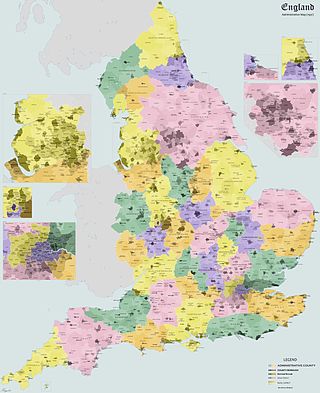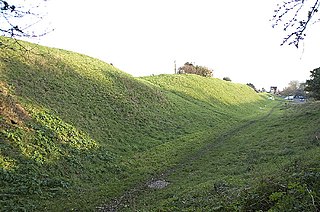Related Research Articles

East Suffolk, along with West Suffolk, was created in 1888 as an administrative county of England. The administrative county was based on the eastern quarter sessions division of Suffolk. East Suffolk County Council's headquarters were at East Suffolk County Hall in Ipswich.

A municipal borough was a type of local government district which existed in England and Wales between 1836 and 1974, in Northern Ireland from 1840 to 1973 and in the Republic of Ireland from 1840 to 2002. Broadly similar structures existed in Scotland from 1833 to 1975 with the reform of royal burghs and creation of police burghs.

The Municipal Corporations Act 1835, sometimes known as the Municipal Reform Act, was an Act of the Parliament of the United Kingdom that reformed local government in the incorporated boroughs of England and Wales. The legislation was part of the reform programme of the Whigs and followed the Reform Act 1832, which had abolished most of the rotten boroughs for parliamentary purposes.

Leicester City Council is a unitary authority responsible for local government in the city of Leicester, England. It consists of 54 councillors, representing 22 wards in the city, overseen by a directly elected mayor. It is currently controlled by the Labour Party and has been led by mayor Sir Peter Soulsby since 2011. The council also appoints a ceremonial Lord Mayor who chairs council meetings; the directly elected mayor is termed the City Mayor to distinguish the post from the Lord Mayor.
Unreformed boroughs were those corporate towns in England and Wales which had not been reformed by the Municipal Corporations Act 1835. A handful of these obtained new charters under the 1835 Act. A royal commission was established in 1876 to inquire into these boroughs, and legislation passed in 1883 finally forced the reform or dissolution of these corporations by 1886.
Cashel is a former British Parliament constituency in Ireland, returning one MP. It was an original constituency represented in Parliament when the Union of Great Britain and Ireland took effect on 1 January 1801.

The County Borough of Leeds, and its predecessor, the Municipal Borough of Leeds, was a local government district in the West Riding of Yorkshire, England, from 1835 to 1974. Its origin was the ancient borough of Leeds, which was reformed by the Municipal Corporations Act 1835. In 1889, when West Riding County Council was formed, Leeds became a county borough outside the administrative county of the West Riding; and in 1893 the borough gained city status. The borough was extended a number of times, expanding from 21,593 acres (8,738 ha) in 1911 to 40,612 acres (16,435 ha) in 1961; adding in stages the former area of Roundhay, Seacroft, Shadwell and Middleton parishes and gaining other parts of adjacent districts. In 1971 Leeds was the fifth largest county borough by population in England. The county borough was abolished in 1974 and replaced with the larger City of Leeds, a metropolitan district of West Yorkshire.

Stockport County Borough was a county-level local authority between 1889 and 1974.

An ancient borough was a historic unit of lower-tier local government in England and Wales. The ancient boroughs covered only important towns and were established by charters granted at different times by the monarchy. Their history is largely concerned with the origin of such towns and how they gained the right of self-government. Ancient boroughs were reformed by the Municipal Corporations Act 1835, which introduced directly elected corporations and allowed the incorporation of new industrial towns. Municipal boroughs ceased to be used for the purposes of local government in 1974, with borough status retained as an honorific title granted to some post-1974 local government districts by the Crown.
Sovereign is a title that can be applied to the highest leader in various categories. The word is borrowed from Old French souverain, which is ultimately derived from the Latin superānus, meaning 'above'.

Ipswich Borough Council is the local authority for Ipswich, a non-metropolitan district with borough status in Suffolk, England. It is the second tier of a two-tier system, fulfilling functions such as refuse collection, housing and planning, with Suffolk County Council providing county council services such as transport, education and social services.

The Municipal Borough of Heywood was, from 1881 to 1974, a local government district in the administrative county of Lancashire, England, with borough status and coterminate with the town of Heywood.

Carlisle was, from 1835 to 1974, a local government district in the northwest of England, coterminate with Carlisle. In 1835, following the Municipal Corporations Act 1835, Carlisle was constituted a municipal borough of Cumberland, but was promoted to county borough status in 1914, within its boundaries taking over the functions of Cumberland County Council. The district was abolished on 31 March 1974 by the Local Government Act 1972.

Ipswich is the county town of Suffolk, England. It is a medieval port and industrial town with a strong transport history; the urban area has a population of 122,000 and currently offers urban transport services for cars, cycles and buses. In addition there are 3 railway stations and regional coach services. London Stansted Airport is accessible by the airlink coach.

Dungarvan Town Council, previously known as Dungarvan Urban District Council, was responsible for administration and some public services in Dungarvan, County Waterford. Records date the establishment of town commissioners in Dungarvan to 1855, being replaced by an urban district council in 1899. Later becoming a town council, the local administrative body was abolished in 2014 as part of reforms under the Local Government Reform Act 2014.

Buckingham was an ancient borough in England centred on the town of Buckingham in the county of Buckinghamshire, and was first recorded in the 10th century. It was incorporated as a borough in 1553/4 and reformed under the Municipal Corporations Act 1835. In 1974, it was abolished as part of local government re-organisation under the Local Government Act 1972, and absorbed by Aylesbury Vale District Council.

Benjamin Brame (1772–1851) was the first mayor of Ipswich Corporation following the creation of the role by the passing of the Municipal Corporations Act 1835. He was elected on 31 December 1835 and commenced his mayoralty on 1 January 1836.
The title Bailiff of Ipswich was used from 1200 to 1834 for the most senior officers of Ipswich Corporation, the municipal corporation that owned property in and was responsible for the government of Ipswich. Although over 40 English towns had been granted corporate status by 1200, with the granting of the charter, Ipswich became one of the first towns to be granted the privilege of having two bailiffs elected by the inhabitants gathered in common council. The office was abolished with the implementation of the Municipal Corporations Act 1835, after which the most senior civic office in Ipswich was Mayor.
Frederick Francis Seekamp was a merchant based in Ipswich, Suffolk active politically in the Ipswich Yellow Party. In 1826 he was accused of corrupt and illegal practices in his role as a Bailiff of Ipswich Corporation, through which he acted as returning officer for the Parliamentary representative for the Borough of Ipswich.
References
See Sources section below for details of cited document referred to using the 'Author(date)' format, for example 'Twich(2008)'.
- ↑ "Account of the setting up of self-government in A.D. 1200" . Retrieved 17 January 2010.
- ↑ Twinch (2008), page 30
- ↑ Blatchly, John. The Town Library of Ipswich. Woodbridge: Boydell Press. ISBN 0851155170.
- ↑ "Reformation and Civil War 1539-1699". St Edmundsbury Borough Council . Retrieved 17 January 2010./
- ↑ Martin (2000), page xxxvi
- 1 2 3 4 Martin (2000), page xxxvii
- ↑ Twinch (2008), page 19
- ↑ "Ipswich & Stowmarket Navigation (River Gipping)". Inland Waterways Association. Archived from the original on 25 July 2009. Retrieved 10 January 2010.
- ↑ Twinch (2008), page 78
- ↑ Allen, David H. (2000). Allen, David (ed.). Ipswich Borough Archives, 1255-1835: a catalogue. Woodbridge (GB) Ipswich: Boydell press Suffolk records society. ISBN 0-85115-772-6.
- ↑ Marjie Bloy (11 October 2002). "Defects in Constitutions of Municipal Corporations". The Victorian Web. Retrieved 19 February 2009.
- ↑ Municipal Corporations Act 1835. 1835. p. 457. Retrieved 16 September 2023.
- ↑ "The History of the Mayoralty" . Retrieved 17 January 2010.
The old corporation (or Assembly) was replaced in 1835 by a Mayor, High Steward, Recorder, ten Aldermen and thirty Councillors, with the usual officers
- ↑ "IPSWICH ELECTION WRIT". Parliamentary Debates (Hansard) . 8 August 1842. Retrieved 17 January 2010.
During the last seven years, or little more, there had been five elections for the borough of Ipswich, and those five elections had produced five petitions
- ↑ "Honorary member of the Metropolitan Commission". Studymode. Retrieved 17 January 2010.
Even in 1841, individual votes were sold openly at Ipswich for £15 (Wright D.G. 1970 p.52).
- ↑ Shaw, Albert (June 1889). "Municipal Government in Great Britain". Political Science Quarterly. 4 (2): 197–229. doi:10.2307/2139337. hdl: 2027/uc2.ark:/13960/t21c1x615 . JSTOR 2139337.
- ↑ "Christchurch Park". Archived from the original on 16 July 2011. Retrieved 14 January 2010.
- ↑ "Ipswich Corporation Transport". Archived from the original on 11 November 2010. Retrieved 14 January 2010.
- ↑ "Ipswich Station Walk Route". Archived from the original on 14 September 2009. Retrieved 14 January 2010.
- ↑ "Ipswich Airport History" . Retrieved 14 January 2010.
- ↑ "Acts of Parliament (i)". Parliamentary Debates (Hansard) . Retrieved 14 January 2010.
- ↑ "Table of Statutes". The Law reports: The Public General Statutes. 38 (Statutes passed in 1900, 63rd and 64th years of Queen Victoria.). 1900.
- ↑ "Ipswich Corporation Act 1948". Parliamentary Debates (Hansard) . Retrieved 14 January 2010.
- ↑ "Telecommunications Act 1984" . Retrieved 14 January 2010.
- Sources
- Twinch C (2008). The history of Ipswich. Breedon Books Publishing. ISBN 978-1-85983-625-5.
- Martin G (2000). Ipswich Borough Archives 1255-1835. Boydell Press. ISBN 0-85115-772-6.